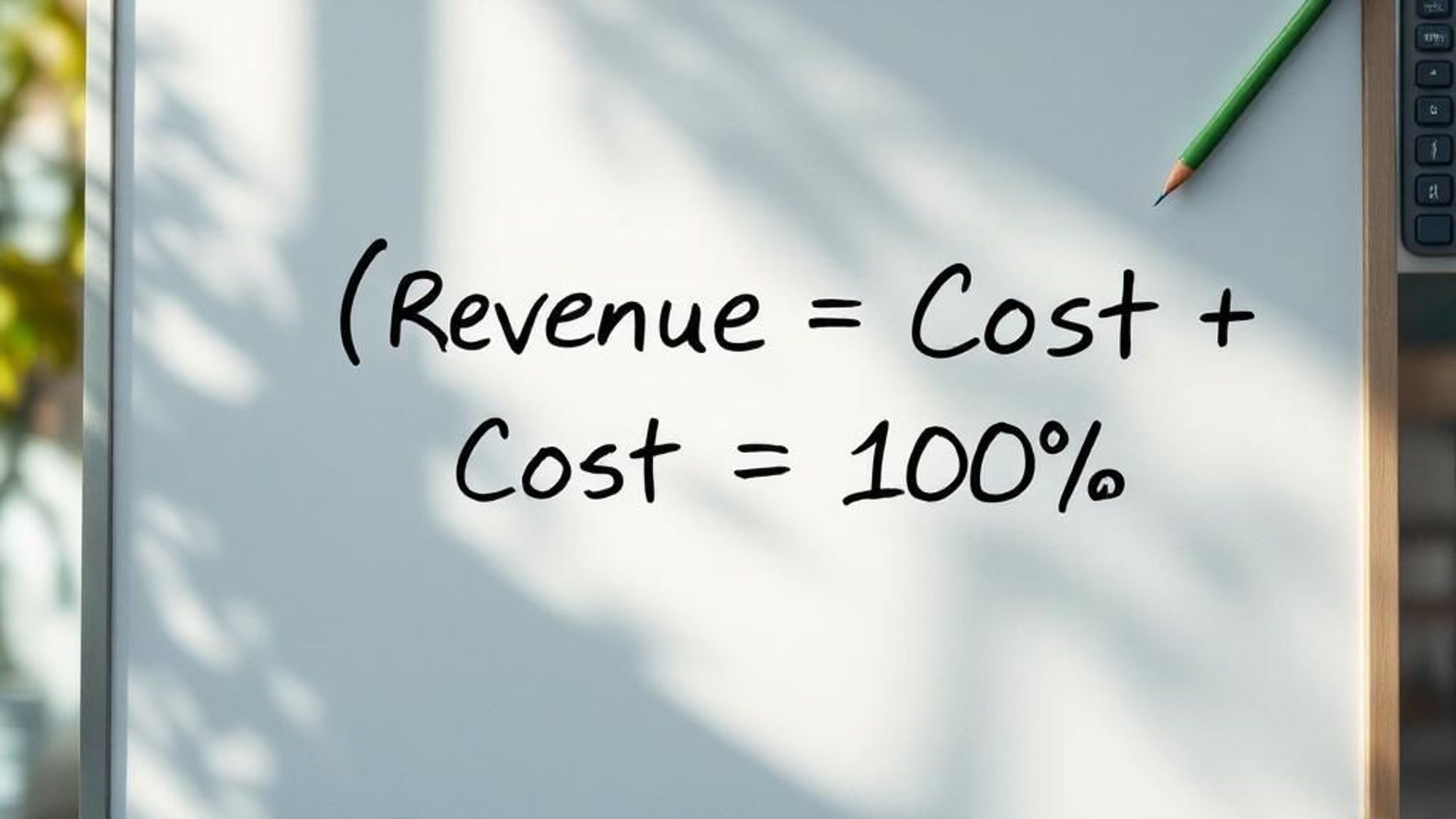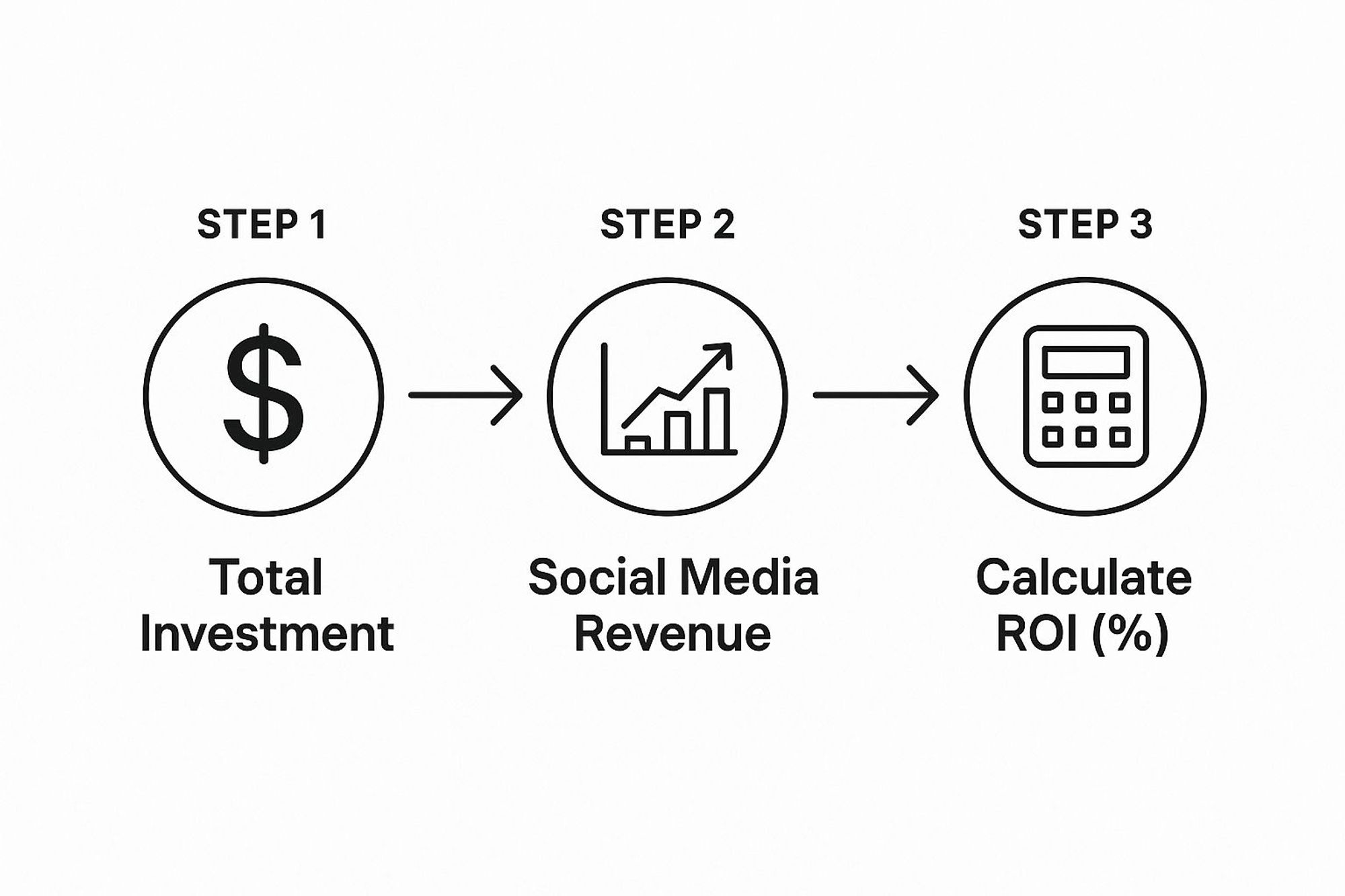Friday, July 4, 2025
How to Calculate Social Media ROI for Better Results


To actually calculate your social media ROI, you have to connect what you do on social media to real, tangible business results. The simplest way to think about it is this: social media ROI is the profit you make from the money you spend on social media marketing. Mastering this isn't just about crunching numbers; it's what separates the marketers who get bigger budgets from those who just make noise.
Moving Beyond Likes to Real Financial Value
Let's be real for a minute. Likes, shares, and new followers feel great, but they don't pay the bills. For a long time, social media was treated like this soft, fuzzy branding channel where "engagement" was the only goal. That kind of thinking is dangerously outdated now.
If you want to prove your team's worth and secure the resources you need, you have to change your perspective. You need to stop seeing social media as just a community forum and start treating it as a powerful revenue engine. This means calculating its ROI is no longer some optional task for the data nerds on your team—it's a core skill for every modern marketer. It’s how you justify what you spend, prove your value, and make smarter bets on where to put your time and money.
From Vanity Metrics to Value Metrics
The first step is learning to tell the difference between the metrics that make you feel good and the metrics that actually move the business forward. While those surface-level stats can give you a hint about your audience's health, they don't paint the whole picture of your financial impact.
A lot of social media professionals get stuck here. They're great at generating activity, but they struggle to connect it to business outcomes.
The most important shift you can make is to stop reporting on activity and start reporting on impact. Instead of saying, "Our post got 10,000 likes," you need to be able to say, "Our campaign brought in 50 new leads, which we value at $5,000."
To get there, you need to understand the two types of metrics at play.
The Shift from Vanity Metrics to Value Metrics
It's easy to get caught up in the numbers that look good on a dashboard. But true ROI comes from tracking the metrics that directly link your social media efforts to business goals. This table breaks down the difference.
| Metric Type | Examples | What It Tells You |
|---|---|---|
| Vanity Metrics | Likes, Follower Count, Shares, Reach, Impressions | "People saw our content and engaged with it." It shows audience presence but doesn't connect directly to revenue. |
| Value Metrics | Conversions, Leads, Revenue per Channel, Customer Lifetime Value (CLV), Cost per Acquisition (CPA) | "Our social media efforts are directly generating business." It measures the financial return and impact on the bottom line. |
Focusing on value metrics is how you start having conversations your leadership team actually cares about. They want to see how marketing contributes to growth, and these are the numbers that tell that story.
The Financial Case for Social Media
Any skepticism about the financial return of social media is fading fast, mainly because the data is just too strong to ignore. Marketers are seeing overwhelmingly positive results from their social media ads.
In fact, a recent study showed that by 2025, around 96% of marketers globally said they got a positive ROI from their social media campaigns. On average, these campaigns are pulling in about a 250% return on ad spend. That means for every single dollar they put in, they're getting back roughly $2.50 in revenue.
You can discover more insights about social media marketing returns and what they could mean for your own strategy. The evidence is clear: if you're not calculating your ROI, you're almost certainly leaving money on the table.
Defining Your Goals and Accounting for Every Cost

Before you can even think about calculating your social media ROI, you have to ask a blunt question: what does "return" actually mean for your business? If you don't have a crystal-clear answer, any numbers you crunch will be completely meaningless.
The truth is, "success" looks different for everyone. An e-commerce brand might be laser-focused on direct sales from an Instagram campaign. But for a B2B software company, a single, high-quality lead from LinkedIn is worth its weight in gold.
That’s why your first move is always to set specific, tangible goals that connect directly to your bigger business objectives. Using effective goal setting frameworks can really help here, making sure your social media efforts are actually pushing the company forward, not just generating vanity metrics.
Tallying Your True Social Media Investment
Here's where a lot of people go wrong. They dramatically underestimate their total investment, and it completely skews their ROI calculation. The "I" in ROI is so much more than just your ad spend—it’s every single resource you pour into your social media strategy.
To get a real, honest number, you have to account for every cost, both obvious and hidden. If you skip this, you'll end up with an inflated return that gives you a false sense of victory.
Let’s break down the costs you absolutely cannot forget:
- Your Team's Time: This is a big one. Your hours and your team's hours are valuable. You need to calculate the cost of the time spent planning, creating content, managing the community, and pulling reports for a given campaign.
- Content Creation Costs: Did you hire a photographer, a video editor, or a freelance copywriter? Those agency and contractor fees are direct costs and must be factored into your investment.
- Tool and Software Subscriptions: Don't forget the monthly or annual fees for your scheduling tools, analytics platforms, or design software. Be sure to prorate the cost for the specific campaign period you're measuring.
- Paid Advertising Spend: This is the most straightforward cost. It's the total budget you put behind your social ads on platforms like Meta, TikTok, or LinkedIn for the campaign.
Remember: The whole point is to build a complete, defensible picture of your investment. When your boss or a client asks how you got your numbers, a detailed cost breakdown shows you’ve done your homework and builds a massive amount of trust.
Putting It All Together for an Accurate Calculation
Once you've got a firm grip on every single cost, the rest of the process is pretty simple. Just add up all those expenses, and you've got the total "Investment" figure for your ROI formula.
If adding all this up by hand sounds like a headache, don't sweat it. You can make this whole thing way easier by using our free social media ROI calculator. Just plug in your costs and returns, and you’ll get a quick, accurate result. It's a great way to make sure you never miss a critical expense.
Tracking the Metrics That Actually Drive Revenue

Alright, let's get real about social media ROI. The only way to prove its value is to draw a straight line from a user’s casual scroll on their timeline all the way to a deposit in your bank account. It’s all about connecting the dots.
This means shifting your focus from fuzzy vanity metrics like impressions and reach to the actions that actually have a price tag. We need to follow the money, and that journey starts with meticulous tracking. This is where tools like UTM parameters, the Meta Pixel, and Google Analytics go from being "nice-to-haves" to your absolute best friends. They're what let you trace a user's path from a social post to a final conversion.
Assigning a Monetary Value to Every Action
Here’s a critical step that so many marketers skip: not every valuable action is a direct sale. To get a true financial picture, you have to assign a clear dollar value to different kinds of conversions.
A B2B company, for example, might look at their historical data and figure out that a qualified lead from LinkedIn is worth $150. This isn't a random number; it's based on their lead-to-customer conversion rate and average deal size. An e-commerce brand might find that a newsletter signup is worth $15, because subscribers, on average, spend that much more over their lifetime.
You can do this for almost any action. Here are a few examples I've seen work well:
- Completed Purchase: This one's easy—it's the total revenue from that sale.
- Demo Request: Calculate the average value of a closed deal and multiply it by your demo-to-close rate.
- Ebook Download: Estimate this based on how often leads from this channel eventually become paying customers.
- Newsletter Signup: Analyze the average lifetime value (LTV) of an email subscriber.
By putting a number on these actions, you can finally quantify the return from campaigns that are designed to fill your sales pipeline, even if they don't drive immediate cash.
Precision Tracking with UTMs and Pixels
To make all these connections, you absolutely need the right tracking infrastructure in place. If you don't have it, you're just making educated guesses about where your revenue is coming from, and that’s not good enough.
UTM parameters are just simple tags you add to the end of your URLs. They act like little breadcrumbs, telling your analytics tools exactly where a click came from. This allows you to attribute website traffic and, more importantly, conversions back to a specific social media post or campaign.
A common mistake I see all the time is inconsistent UTM usage. It completely muddies your data. Do yourself a favor and create a clear naming convention for your team to follow for source, medium, and campaign. It makes for clean, reliable reporting.
Platform pixels, like the Meta Pixel or TikTok Pixel, are tiny snippets of code you place on your website. They're incredibly powerful. They track user actions, help you build custom audiences for retargeting, and optimize your ad delivery for conversions. For instance, when you're looking at lead generation ads on Facebook and their measurable ROI, those campaigns live and die by the data their pixel collects.
The impact of social commerce is just too big to ignore. In 2025, social networks are expected to account for 17.11% of all online sales worldwide. That number highlights just how much revenue is flowing directly through these channels. The market is also growing at a blistering pace, with a projected compound annual growth rate of 13.7%. To see these principles in action, you can start by measuring social media success on platforms like Threads.
Putting the Social Media ROI Formula to Work
Knowing the formula is one thing, but actually plugging in the numbers from a real campaign is where things get interesting. The math is simple enough: (Profit - Investment) / Investment x 100. The real skill, though, is figuring out what counts as "profit" and "investment" in different situations.
Let's step away from the theory and look at how this plays out with a couple of practical examples. This is how you turn fuzzy campaign goals into hard numbers that prove your work is paying off.
The visual below gives you a clean workflow for calculating social media ROI. It shows how your initial spend turns into revenue, which you then use for the final calculation.

This chart helps break down the journey from spending money to measuring what you got back, making the whole thing less intimidating to tackle.
E-Commerce Brand on Instagram
Picture a small e-commerce brand that sells custom pet portraits. They decide to run an Instagram Stories ad campaign for one month, with the clear goal of driving sales directly from the ads.
Here’s how they'd tally up their ROI.
Investment:
- Ad Spend: They put $1,000 directly into Instagram ads.
- Content Creation: They hired a freelance video editor for $300 to make the ads pop.
- Team Time: The social media manager spent about 10 hours on the campaign. At an internal rate of $40/hour, that's $400 in salary cost.
Their Total Investment shakes out to be $1,700.
Return: By using their Shopify dashboard and proper UTM tracking, they can confidently attribute $5,200 in sales directly to this campaign.
Calculation:
- ( $5,200 - $1,700 ) / $1,700 = 2.05
- 2.05 x 100 = 205% ROI
A 205% ROI is a fantastic result. It tells the brand that for every single dollar they spent, they made $2.05 in profit. That’s a green light to reinvest in similar campaigns, knowing they've found a winning strategy.
B2B Firm Valuing LinkedIn Leads
Now let's switch gears to a B2B SaaS company. They're using LinkedIn to get people to sign up for product demos. Their sales cycle is much longer, so tracking immediate sales from a single ad is unrealistic. Instead, they calculate ROI based on the value of each lead.
One of the biggest mistakes B2B marketers make is not assigning a dollar value to top-of-funnel conversions like a demo request. If you don't, your efforts become invisible to leadership, and it's impossible to prove your ROI.
Let's say their historical data shows that 1 in every 10 demo requests eventually becomes a paying customer. And their average customer lifetime value (CLV) is $5,000.
This means each demo request is worth $500 ($5,000 / 10).
Investment:
- Ad Spend: $2,500 for their LinkedIn campaign.
- Team Time & Tools: $1,500 to cover prorated salaries and software subscriptions.
- Total Investment: $4,000
Return: The campaign brought in 20 qualified demo requests.
- 20 leads x $500/lead = $10,000 in potential pipeline value.
Calculation:
- ( $10,000 - $4,000 ) / $4,000 = 1.5
- 1.5 x 100 = 150% ROI
Even without a single sale yet, they can prove the campaign generated significant value for the sales pipeline. To keep tabs on these kinds of complex metrics, you need to see all your data in one place. Learning how to build a great social media analytics dashboard is key to tracking these results over time and showing that your LinkedIn strategy is doing its job.
Essential Tools for Streamlining Your ROI Reporting
Let's be honest: manually pulling data from a dozen different sources is a recipe for burnout and costly mistakes. I've been there, and it's not pretty. To really nail your social media ROI, you need a workflow that's efficient, not chaotic. That means ditching the messy spreadsheets and embracing tools that automate data collection and make reporting a breeze.
The good news? You don't need a huge budget to get started. Your first stop should always be the analytics dashboards built right into the social platforms you're already using.
Leveraging Native Platform Analytics
Every major social network offers its own suite of analytics tools, and they're a goldmine of data—completely free. These are your foundational building blocks for understanding on-platform performance and gathering the raw numbers for your ROI calculations.
- Meta Business Suite: This is your go-to for deep dives into Facebook and Instagram. It gives you detailed insights on reach, engagement, and audience demographics. The Ads Manager is especially critical for tracking conversion events and your return on ad spend (ROAS).
- LinkedIn Analytics: For B2B marketers, this is invaluable. It provides powerful data on everything from visitor demographics and content performance to follower growth, making it perfect for tracking lead generation.
- TikTok Analytics: This gives you a crystal-clear view of video performance, profile views, and follower trends. It's the key to understanding what your audience is actually watching and engaging with on the platform.
While these tools are fantastic, they all live in their own little worlds. Juggling multiple dashboards gets old fast, which is exactly where dedicated social media management platforms come into play.
Centralizing Your Data with Management Tools
Think of comprehensive tools like Sprout Social or Hootsuite as your central command center. They pull data from all your connected profiles into one dashboard, saving you an incredible amount of time and hassle.
The real magic of these platforms isn't just scheduling posts; it's how they streamline reporting. By consolidating all your metrics in one place, you can quickly compare performance across different channels and campaigns. This makes it so much easier to spot what’s working and what’s a waste of time.
This centralized view is what allows you to tell a coherent story about your overall performance. And when you're looking at different software, checking out various video ad optimization tools can also give you an edge in maximizing the return from your visual content.
Integrating with Google Analytics for a Full Picture
The final piece of the puzzle is connecting your social media data to what's happening on your website. This is where Google Analytics (GA4) becomes your best friend. By using consistent UTM parameters on every link you share on social media, you can track exactly how those users behave once they land on your site.
This integration lets you see the entire customer journey, from that first click on a social post all the way to a final purchase or lead submission. It's the most powerful way to attribute real, hard revenue back to your social media activities.
A well-organized reporting stack like this is a core part of any successful social media marketing plan template, ensuring your efforts are always tied to measurable business results.
Common Questions About Measuring Social Media ROI

Even with a solid formula and the right tools in your corner, a few tricky questions always seem to pop up when it's time to actually calculate social media ROI. These common hangups can make the whole process feel way more complicated than it needs to be.
So, let's clear the air and tackle some of the most frequent challenges I see marketers wrestle with.
One of the biggest hurdles is tracking the return on campaigns that aren’t even designed for direct sales. How in the world do you put a dollar value on something as fuzzy as "brand awareness"? This is where getting creative with proxy metrics is a game-changer.
How Do I Measure ROI For Brand Awareness Goals?
You're right, you can't always draw a neat, straight line from an awareness campaign to a sale. But that doesn't mean you can't assign a real, tangible value to its impact. The key is to look at metrics that prove your brand's influence is growing and then translate that into a monetary figure.
A few powerful proxy metrics I lean on are:
- Share of Voice: How much of the conversation in your industry is about your brand versus the competition?
- Branded Search Volume: Are more people plugging your company name directly into Google? That's a huge signal that awareness is on the rise.
- Audience Growth: A steady climb in genuine followers shows your message is hitting the mark.
A fantastic way to quantify this is by calculating your Earned Media Value (EMV). If your organic campaign generated one million impressions, figure out what it would have cost to buy those same impressions with paid ads. This gives you a defensible, albeit indirect, value for your brand-building work.
How Often Should I Calculate My ROI?
The honest answer? It depends entirely on your business cycle and how your campaigns are structured. There's no single "right" answer here, but there are some solid guidelines you can follow to stay on track and make smart, timely decisions.
For your day-to-day social media management and ongoing content, a monthly ROI report is a great rhythm to get into. It lets you spot trends and see what's working without overreacting to the small, daily ups and downs.
But for short-term campaigns—think a product launch, a flash sale, or an event promotion—you need to calculate the ROI the moment it wraps up. This gives you an immediate, clear verdict on its success and a ton of insight for the next one. A broader quarterly review is also non-negotiable for high-level strategy and locking in your annual budget.
What Is a Good Social Media ROI?
Ah, the million-dollar question. And the honest-to-goodness answer is: it depends. A "good" ROI can look wildly different depending on your industry, platform, profit margins, and what you were trying to achieve in the first place. An e-commerce brand selling low-cost items needs a completely different return than a B2B SaaS company closing six-figure deals.
That said, there are some general benchmarks that many marketing experts nod along to. A 5:1 return, which is a 400% ROI, is widely considered strong. If you're hitting a 10:1 return (900% ROI), you're doing something exceptional.
But the most important benchmark is always your own past performance. The real goal should be continuous improvement. Figure out your baseline ROI, then make it your mission to beat it every quarter through smart testing and optimization. A great place to start is to boost social media engagement, since more interaction almost always leads to better conversion rates and a healthier return.
No credit card required!